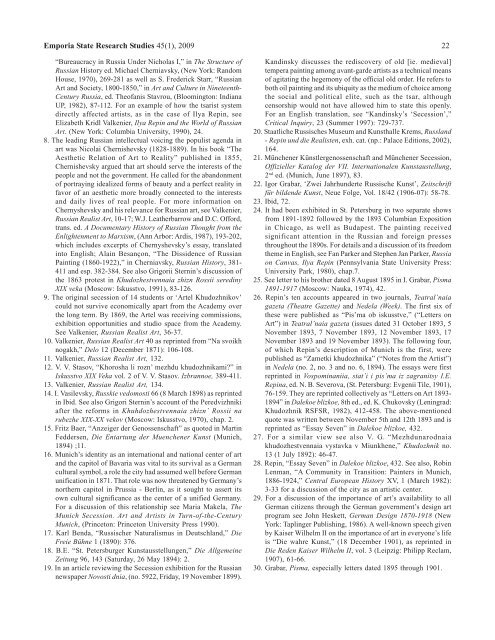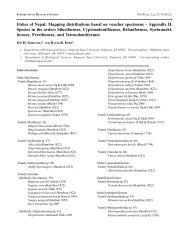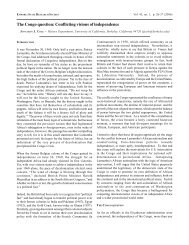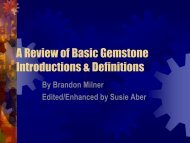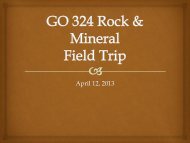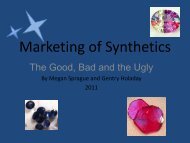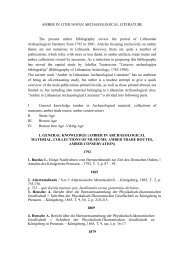Russian émigré artists and political opposition in fin-de-siècle Munich
Russian émigré artists and political opposition in fin-de-siècle Munich
Russian émigré artists and political opposition in fin-de-siècle Munich
- No tags were found...
You also want an ePaper? Increase the reach of your titles
YUMPU automatically turns print PDFs into web optimized ePapers that Google loves.
Emporia State Research Studies 45(1), 2009 22“Bureaucracy <strong>in</strong> Russia Un<strong>de</strong>r Nicholas I,” <strong>in</strong> The Structure of<strong>Russian</strong> History ed. Michael Cherniavsky, (New York: R<strong>and</strong>omHouse, 1970), 269-281 as well as S. Fre<strong>de</strong>rick Starr, “<strong>Russian</strong>Art <strong>and</strong> Society, 1800-1850,” <strong>in</strong> Art <strong>and</strong> Culture <strong>in</strong> N<strong>in</strong>eteenth-Century Russia, ed. Theofanis Stavrou, (Bloom<strong>in</strong>gton: IndianaUP, 1982), 87-112. For an example of how the tsarist systemdirectly affected <strong>artists</strong>, as <strong>in</strong> the case of Ilya Rep<strong>in</strong>, seeElizabeth Kridl Valkenier, Ilya Rep<strong>in</strong> <strong>and</strong> the World of <strong>Russian</strong>Art. (New York: Columbia University, 1990), 24.8. The lead<strong>in</strong>g <strong>Russian</strong> <strong>in</strong>tellectual voic<strong>in</strong>g the populist agenda <strong>in</strong>art was Nicolai Chernishevsky (1828-1889). In his book “TheAesthetic Relation of Art to Reality” published <strong>in</strong> 1855,Chernishevsky argued that art should serve the <strong>in</strong>terests of thepeople <strong>and</strong> not the government. He called for the ab<strong>and</strong>onmentof portray<strong>in</strong>g i<strong>de</strong>alized forms of beauty <strong>and</strong> a perfect reality <strong>in</strong>favor of an aesthetic more broadly connected to the <strong>in</strong>terests<strong>and</strong> daily lives of real people. For more <strong>in</strong>formation onChernyshevsky <strong>and</strong> his relevance for <strong>Russian</strong> art, see Valkenier,<strong>Russian</strong> Realist Art, 10-17; W.J. Leatherbarrow <strong>and</strong> D.C. Offord,trans. ed. A Documentary History of <strong>Russian</strong> Thought from theEnlightenment to Marxism, (Ann Arbor: Ardis, 1987), 193-202,which <strong>in</strong>clu<strong>de</strong>s excerpts of Chernyshevsky’s essay, translated<strong>in</strong>to English; Ala<strong>in</strong> Besançon, “The Dissi<strong>de</strong>nce of <strong>Russian</strong>Pa<strong>in</strong>t<strong>in</strong>g (1860-1922),” <strong>in</strong> Cherniavsky, <strong>Russian</strong> History, 381-411 <strong>and</strong> esp. 382-384. See also Grigorii Stern<strong>in</strong>’s discussion ofthe 1863 protest <strong>in</strong> Khudozhestvennaia zhizn Rossii sered<strong>in</strong>yXIX veka (Moscow: Iskusstvo, 1991), 83-126.9. The orig<strong>in</strong>al secession of 14 stu<strong>de</strong>nts or ‘Artel Khudozhnikov’could not survive economically apart from the Aca<strong>de</strong>my overthe long term. By 1869, the Artel was receiv<strong>in</strong>g commissions,exhibition opportunities <strong>and</strong> studio space from the Aca<strong>de</strong>my.See Valkenier, <strong>Russian</strong> Realist Art, 36-37.10. Valkenier, <strong>Russian</strong> Realist Art 40 as repr<strong>in</strong>ted from “Na svoikhnogakh,” Delo 12 (December 1871): 106-108.11. Valkenier, <strong>Russian</strong> Realist Art, 132.12. V. V. Stasov, “Khorosha li rozn’ mezhdu khudozhnikami?” <strong>in</strong>Iskusstvo XIX Veka vol. 2 of V. V. Stasov. Izbrannoe, 389-411.13. Valkenier, <strong>Russian</strong> Realist Art, 134.14. I. Vasilevsky, Russkie vedomosti 66 (8 March 1898) as repr<strong>in</strong>ted<strong>in</strong> Ibid. See also Grigori Stern<strong>in</strong>’s account of the Peredvizhnikiafter the reforms <strong>in</strong> Khuhdozhestvennaia zhizn’ Rossii narubezhe XIX-XX vekov (Moscow: Iskusstvo, 1970), chap. 2.15. Fritz Baer, “Anzeiger <strong>de</strong>r Genossenschaft” as quoted <strong>in</strong> Mart<strong>in</strong>Fed<strong>de</strong>rsen, Die Entartung <strong>de</strong>r Muenchener Kunst (<strong>Munich</strong>,1894) ;11.16. <strong>Munich</strong>’s i<strong>de</strong>ntity as an <strong>in</strong>ternational <strong>and</strong> national center of art<strong>and</strong> the capitol of Bavaria was vital to its survival as a Germancultural symbol, a role the city had assumed well before Germanunification <strong>in</strong> 1871. That role was now threatened by Germany’snorthern capitol <strong>in</strong> Prussia - Berl<strong>in</strong>, as it sought to assert itsown cultural significance as the center of a unified Germany.For a discussion of this relationship see Maria Makela, The<strong>Munich</strong> Secession. Art <strong>and</strong> Artists <strong>in</strong> Turn-of-the-Century<strong>Munich</strong>, (Pr<strong>in</strong>ceton: Pr<strong>in</strong>ceton University Press 1990).17. Karl Benda, “Russischer Naturalismus <strong>in</strong> Deutschl<strong>and</strong>,” DieFreie Bühne 1 (1890): 376.18. B.E. “St. Petersburger Kunstausstellungen,” Die Allgeme<strong>in</strong>eZeitung 96, 143 (Saturday, 26 May 1894): 2.19. In an article review<strong>in</strong>g the Secession exhibition for the <strong>Russian</strong>newspaper Novosti dnia, (no. 5922, Friday, 19 November 1899).K<strong>and</strong><strong>in</strong>sky discusses the rediscovery of old [ie. medieval]tempera pa<strong>in</strong>t<strong>in</strong>g among avant-gar<strong>de</strong> <strong>artists</strong> as a technical meansof agitat<strong>in</strong>g the hegemony of the official old or<strong>de</strong>r. He refers toboth oil pa<strong>in</strong>t<strong>in</strong>g <strong>and</strong> its ubiquity as the medium of choice amongthe social <strong>and</strong> <strong>political</strong> elite, such as the tsar, althoughcensorship would not have allowed him to state this openly.For an English translation, see “K<strong>and</strong><strong>in</strong>sky’s ‘Secession’,”Critical Inquiry, 23 (Summer 1997): 729-737.20. Staatliche Russisches Museum <strong>and</strong> Kunsthalle Krems, Russl<strong>and</strong>- Rep<strong>in</strong> und die Realisten, exh. cat. (np.: Palace Editions, 2002),164.21. Münchener Künstlergenossenschaft <strong>and</strong> Münchener Secession,Offizieller Katalog <strong>de</strong>r VII. Internationalen Kunstaustellung,2 nd ed. (<strong>Munich</strong>, June 1897), 83.22. Igor Grabar, ‘Zwei Jahrhun<strong>de</strong>rte Russische Kunst’, Zeitschriftfür bil<strong>de</strong>n<strong>de</strong> Kunst, Neue Folge, Vol. 18/42 (1906-07): 58-78.23. Ibid, 72.24. It had been exhibited <strong>in</strong> St. Petersburg <strong>in</strong> two separate showsfrom 1891-1892 followed by the 1893 Columbian Exposition<strong>in</strong> Chicago, as well as Budapest. The pa<strong>in</strong>t<strong>in</strong>g receivedsignificant attention <strong>in</strong> the <strong>Russian</strong> <strong>and</strong> foreign pressesthroughout the 1890s. For <strong>de</strong>tails <strong>and</strong> a discussion of its freedomtheme <strong>in</strong> English, see Fan Parker <strong>and</strong> Stephen Jan Parker, Russiaon Canvas, Ilya Rep<strong>in</strong> (Pennsylvania State University Press:University Park, 1980), chap.7.25. See letter to his brother dated 8 August 1895 <strong>in</strong> I. Grabar, Pisma1891-1917 (Moscow: Nauka, 1974), 42.26. Rep<strong>in</strong>’s ten accounts appeared <strong>in</strong> two journals, Teatral’naiagazeta (Theatre Gazette) <strong>and</strong> Ne<strong>de</strong>la (Week). The first six ofthese were published as “Pis’ma ob iskusstve,” (“Letters onArt”) <strong>in</strong> Teatral’naia gazeta (issues dated 31 October 1893, 5November 1893, 7 November 1893, 12 November 1893, 17November 1893 <strong>and</strong> 19 November 1893). The follow<strong>in</strong>g four,of which Rep<strong>in</strong>’s <strong>de</strong>scription of <strong>Munich</strong> is the first, werepublished as “Zametki khudozhnika” (“Notes from the Artist”)<strong>in</strong> Ne<strong>de</strong>la (no. 2, no. 3 <strong>and</strong> no. 6, 1894). The essays were firstrepr<strong>in</strong>ted <strong>in</strong> Vospom<strong>in</strong>aniia, stat’i i pis’ma iz zagranitsy I.E.Rep<strong>in</strong>a, ed. N. B. Severova, (St. Petersburg: Evgenii Tile, 1901),76-159. They are repr<strong>in</strong>ted collectively as “Letters on Art 1893-1894” <strong>in</strong> Dalekoe blizkoe, 8th ed., ed. K. Chukovsky (Len<strong>in</strong>grad:Khudozhnik RSFSR, 1982), 412-458. The above-mentionedquote was written between November 5th <strong>and</strong> 12th 1893 <strong>and</strong> isrepr<strong>in</strong>ted as “Essay Seven” <strong>in</strong> Dalekoe blizkoe, 432.27. For a similar view see also V. G. “Mezhdunarodnaiakhudozhestvennaia vystavka v Miunkhene,” Khudozhnik no.13 (1 July 1892): 46-47.28. Rep<strong>in</strong>, “Essay Seven” <strong>in</strong> Dalekoe blizkoe, 432. See also, Rob<strong>in</strong>Lenman, “A Community <strong>in</strong> Transition: Pa<strong>in</strong>ters <strong>in</strong> <strong>Munich</strong>,1886-1924,” Central European History XV, 1 (March 1982):3-33 for a discussion of the city as an artistic center.29. For a discussion of the importance of art’s availability to allGerman citizens through the German government’s <strong>de</strong>sign artprogram see John Heskett, German Design 1870-1918 (NewYork: Tapl<strong>in</strong>ger Publish<strong>in</strong>g, 1986). A well-known speech givenby Kaiser Wilhelm II on the importance of art <strong>in</strong> everyone’s lifeis “Die wahre Kunst,” (18 December 1901), as repr<strong>in</strong>ted <strong>in</strong>Die Re<strong>de</strong>n Kaiser Wilhelm II, vol. 3 (Leipzig: Philipp Reclam,1907), 61-66.30. Grabar, Pisma, especially letters dated 1895 through 1901.


